
For more than 45 years, Tom Palmore’s portraits of animals have earned him a distinctive reputation for his masterful technical prowess and his reverence for his subject. His hyperreal renderings of animals in oil and acrylic offer a unique, and often comical, juxtaposition of technical literalism and surreal, imaginative context—questioning the established conventions of photography and painting, especially as evident in the portrait genre.
Palmore’s witty and whimsical portraits take our human inclination toward the personification of animals to an extreme. It has been said of the artist that he approaches each painting as though it were commissioned by the subject itself. This role reversal, between artist and subject, is perhaps one of the principal ways the artist achieves the illusionary quality so intrinsic to his work. “My paintings are about other earthlings that we share this planet with… and about our relationship with them.” Palmore’s paintings have a masterful eloquence that elevates his subjects’ status and renders them in oil and acrylic with the dignity—even personality— suggestive of his view of their full partnership on the earth with humans.
Born in Oklahoma in 1945, Tom Palmore was a student at the Pennsylvania Academy of Fine Arts in Philadelphia in the late 1960s. His work is in collections as the Smithsonian Institution, the Whitney Museum of American Art, the Brooklyn Museum, the Philadelphia Museum of Art, the Denver Museum of Art, the New Orleans Museum of Art, the National Museum of Wildlife art, the Saint Louis Museum of Art, and the Indianapolis Museum of Art.

TOM PALMORE BIG CATS, BIRDS, AND A COUPLE OF DOGS August 25 – September 23. 2023 1613 Paseo de Peralta | Santa Fe, New Mexico 87501 | 505.988.3250 | lewallengalleries.com | contact@lewallengalleries.com Cover: Indian Princess (detail), oil and acrylic on canvas, 36" x 60"
Tom Palmore
BIG CATS, BIRDS, AND A COUPLE OF DOGS
August 25 - September 23, 2023
Pulling a rabbit out of a hat is not an easy trick, but pulling one out of a hat that is suspended in midair truly is magic—or the illusion of it. Artist Tom Palmore’s recent painting Magic heightens the illusion through hyperrealism and a dash of the surreal. Combined, these techniques lend the image of a gloved hand using a magic wand to conjure the rabbit a different weight than if it was merely a nostalgic reflection of a child’s first experience with a magic show.
Or do they? A memory lodges itself in the mind and begins a slow transformation over time into another facet of one’s own myth. The rabbit out of the hat is a signature of the arch-image that razzles and dazzles with tricks and feats. It is also a metaphor for creating something from nothing, for revealing what was once hidden. This is an example of the multiple dimensions and sophisticated possibilities mirrored in the allegorical heft of Palmore’s amazingly detailed and beautiful paintings.
Palmore is an artist of a playful nature. His titles reflect the imagery of his works, appearing like puns or as matter-of-fact descriptions that take on double meanings. A certain delight is derived from his paintings, which are whimsical, but invite deeper considerations that reach beyond the surface humor. Leonardo Had a Cat, for instance, pairs a nonchalant feline with a bronze sculpture of a horse. Sitting on the horse’s back as though the world was its oyster, it can bring a smile from us cat lovers, but Palmore, for whom big cats are a major recurring them, reflects on the artist’s nature, which is like that of a cat: independent, self-aware, cunningly intelligent, and with some secrets to reveal.
That’s how I think of Palmore.
He knows how a juxtaposition, like that between a living being and a bronze monument, creates layers of meaning, and he does it again in Snowy Owl. The subject perches on the long, carved beak of a tribal bird sculpture as though calling attention to itself and saying, “I am this magic power.” It gives one pause to reflect on the mysteries of the hidden life of animals. Palmore lends his subjects majesty. They appear, at times, like the outer reflection of the inner animal spirit—as its representative. They invite deeper contemplation while allowing adoring admiration.
Palmore was born in Oklahoma in 1945. In the 1960s, after attending Atelier Chapman Kelly in Dallas, Texas, he studied at the Pennsylvania Academy of the Fine Arts in Philadelphia. An art student pulls, consciously or not, from the deep well of art history. And so, as art historian Susan Hallsten McGarry points out in Earthlings: The Paintings of Tom Palmore (Quaid Publishing, 2008), Palmore’s work reflects that of Arshile Gorky, Joan Miró, René Magritte, Grant Wood, and others. But the creation of a Palmore painting doesn’t begin or end in an homage so much as it does in veils of symbolism weaved within each composition. It is an ever-complex synthesis.
Golden Boy, for instance, is a portrait of a stately lion encircled by blue butterflies, which brings contrast to what lies beneath the lion’s serene expression (a beast of a fearsome nature). The lion is set against an Henri Rousseau-like backdrop, which is rendered as a backdrop, as something placed behind a live model, lending it the feeling of a studio portrait.
But is it a Rousseau, cleverly worked into the composition to position it as part of an artistic pedigree? Palmore replaces the dignified figures of royalty and aristocracy, commemorated in historical paintings from periods such as the Baroque and the Neoclassical, with the figures of beasts.
There is no sense of irony in this from his perspective. To Palmore, a lion, a housecat, an owl, and the occasional dog, are regal subjects in their own right and on their own terms. And so, a line is drawn at the point in which anthropomorphism threatens to change a subject’s nature into something it is not.
Palmore was still living and working in Philadelphia in the early 1980s when legendary Santa Fe gallerist Elaine Horwitch saw his work in an exhibition in Washington, D.C. The moment was kismet as Palmore was seeking a gallery to represent him in the Southwest at the time. Soon, he headed to Santa Fe, entering into a sometimes contentious but heart-filled exchange with Horwitch, who offered him his first show at their initial meeting.
“Fueled by oil money and a resurgence of interest in western American art, the marketplace in the Southwest was booming, and Palmore’s reputation for realism and scale put him on the leading edge of contemporary painters,” writes McGarry.
And it is a position he’s maintained for more than 40 years as a premier contemporary portraitist. He’s not a wildlife painter, as he’s often erroneously referred. He paints the animal kingdom within. Again, it is not so much as an anthropomorphic gesture as a call to the wild. Beneath the formalities hoisted on us by society lies the animal instinct…and the knowing.
Reflecting on Dog and Pony Show, in which a toy-sized dog stands on its hind legs on the back of a pony as part of a literal namesake show, one notices the blue curtain, just like the one in Magic. Is it all a part of the big scene, the stage, or circus ring of life?
Inherent in these works is an implied reminder that unfortunately not all animals are lucky enough to be the subjects of Palmore’s portraiture and too many are the objects of abuse and mistreatment in this world. In a way, his paintings are both a reminder of this fact but, also, a quiet act of justice.
—Michael Abatemarco

4
Leopard Eyes
Oil and acrylic on board, 24 x 36 inches

5

6
Queen of the Nile
Oil and acrylic on canvas, 36 x 60 inches

7

8
Tiger Eyes
Oil and acrylic on board, 24 x 36 inches
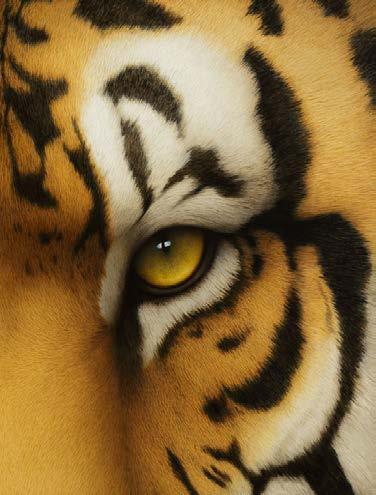
9

10
King of the Jungle Oil and acrylic on canvas, 36 x 60 inches

11

12
13
Golden Boy Oil and acrylic on canvas, 35 x 32.75 inches
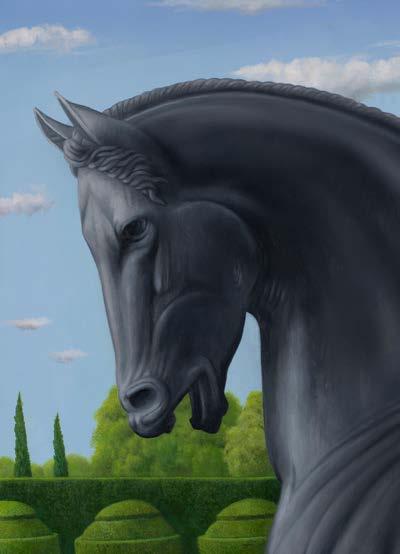
14
Leonardo Had A Cat
Oil and acrylic on canvas, 42 x 60 inches

15
16
Pretty Girl Oil and acrylic on canvas, 36 x 36 inches
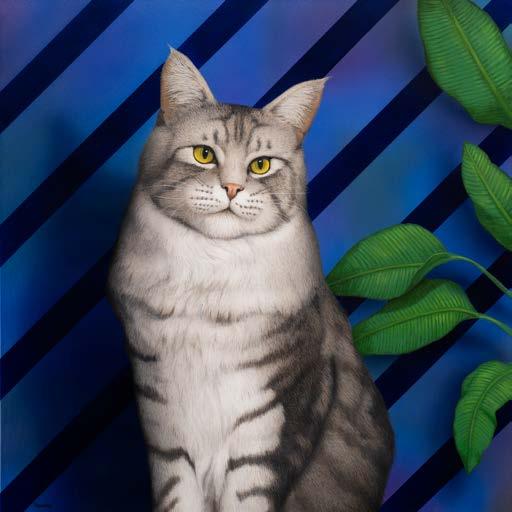
17

18
Dog and Pony Show
Oil and acrylic on canvas, 36 x 60 inches
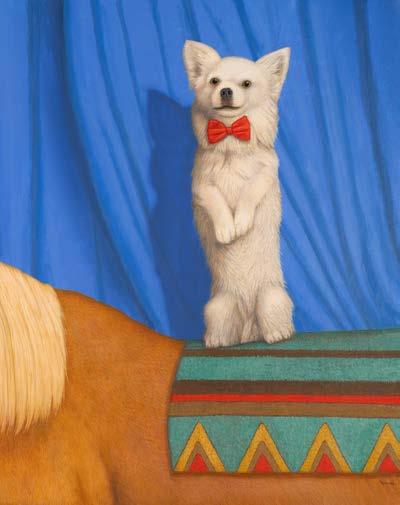
19

20
21
Good Evening Casanova Oil and acrylic on canvas, 40 x 30 inches
Love at First Sight
Oil and acrylic on canvas, 36 x 48 inches

22

23
24
Snowy Owl Oil and acrylic on canvas, 48 x 36 inches
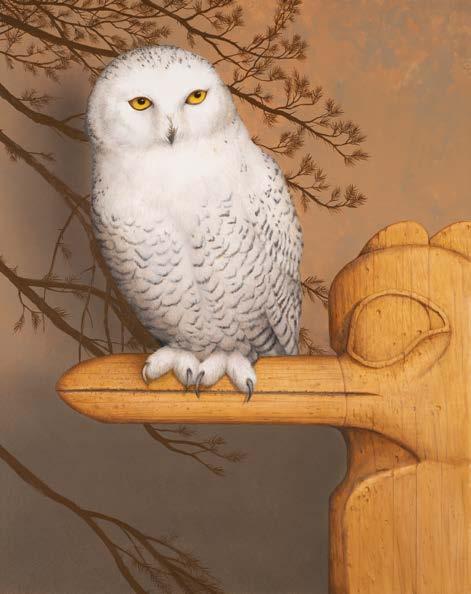
25

26
Great Blue Heron
Oil and acrylic on canvas, 36 x 48 inches

27

28
29
Magic Oil and acrylic on canvas, 40 x 30 inches

30
Flying Kangaroo Mouse Oil and acrylic on panel, 18 x 24 inches

31
32
Mr. Personality Oil and acrylic on panel, 20 x 16 inches

33

34
Indian Princess Oil and acrylic on canvas, 36 x 60 inches

35

37
Ship Rock Oil and acrylic on panel, 30 x 24 inches
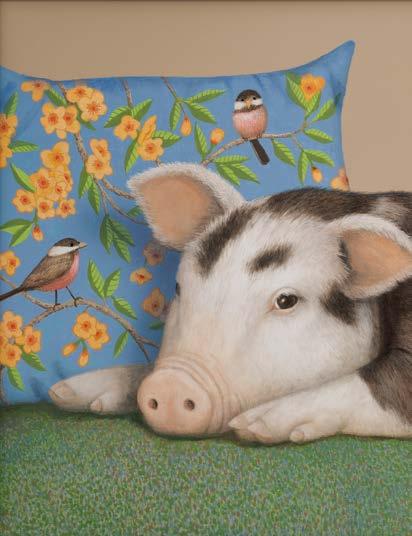
38
Reclining Nude
Oil and acrylic on canvas, 24 x 36 inches
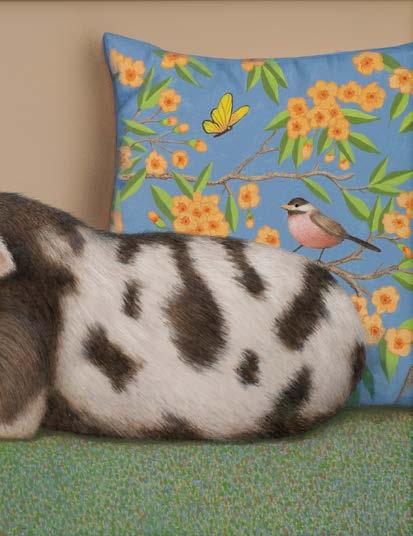
39

40
Big Cat Country
Oil and acrylic on canvas, 42 x 60 inches
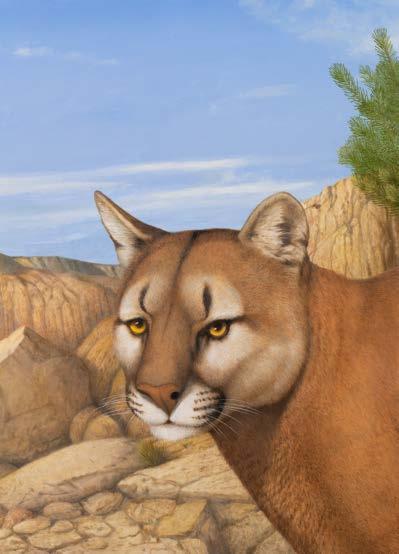
41





































